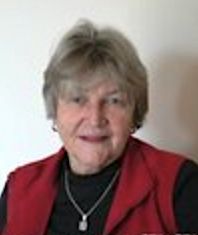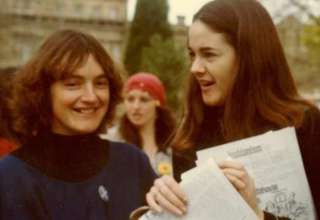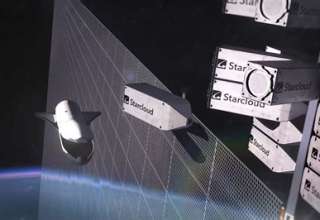29 September 1937 – 5 May 2023
by Humphrey McQueen
Old Parliament House, June 17, 2023
When Lyndall asked me to speak this morning, I was honoured, and taken aback.
Manning used to hum ‘I’m forever writing Prefaces.’ I’m beginning to feel as if I’m forever penning obituaries. As I recall the people who have shaped my life, I realise that I am drafting my own.
Julia had been the person whom I had known longest and with whom I was still in touch, having met in Brisbane in 1960. Her Auchenflower ALP branch was in the same Federal electorate, Ryan, contested for Labor in 1961 elections by Joy Guyatt, Special Collections Librarian at the University. No surprise that a woman could stand in a Tory stronghold.
I baby-sat for Keir, named for the leader of the Independent Labour Party, Keir Hardie.
Julia had come to Brisbane with her then husband, Bruce McFarlane, who was one of a clutch of radicals that year, appointed in by the maverick Economics Professor J.K. Gifford. They included Helen Hughes and Ingrid Palmer with Merle Thornton in Philosophy.
At the time, there was a Staff Room for Ladies. That didn’t last a week. Merle later chained herself to the bar in one of the four University watering holes, the Regatta.[1] Julia’s second son, Neil, is named after Merle’s husband.
Julia took a job in a State High School, then something of a novelty, and not only in Queensland. Up there, married women teachers had to resign on the last day of the year and were not paid again until the first of term next year.
It was around then that I met Julia’s mother, Edna, renowned for her on-going struggle for equal pay, and recognised as the godmother of the women’s movement.[2] Knowing her was an education in itself.
During the 1962 visit by King Bhumibol and Queen Sirikit of Thailand, Edna referred to them as King Bum and Queen Shit. Republicanism ran wide and deep in the Ryan clan.
At Julia’s parties, I imbibed revolutionary songs from her. We’ll catch her fine voice as I recite snatches from a few of them.
Kevin Barry
Shoot me like an Irish soldier
Do not hang me like a dog
For I fought for Ireland’s freedom
In that cold September fog.
The Internationale
So it’s comrades come rally
And the last fight let us face,
For the Internationale unites the human race.
Inevitably, Joe Hill
Where working folk defend their rights,
That’s where you find Joe Hill.
Julia and Biff came to the Woden Tradies for the concert on the centenary of his murder in 1916. And a local one from the Wobbies’
Bump Me Into Parliament
Yes I am a Labor man
And believe in Revolution,
The quickest way to bring it on
Is talking constitution.
And, of course, Spain. They might have won the war, but we had all the best songs.
There was a rat,
Big and fat,
A rat by the name of Franco.
So much history brought to life to inspire a teenage radical.
Julia came to the annual gathering in honour of the Australians who had volunteered to fight fascism. This year will be the 30th anniversary of its installation, organised by two of Julia’s friends, Neta Burns and Amirah Inglis. We hope to see you all there, a bit before noon on the second Sunday in December, close to the Nara Peace Park by the lake.
The Spanish memorial is one stop on a tour of radical Canberra and district which Peter and I guide friends and visitors around. Earlier this year, I went with Julia, Pam and Lyndall. The tour includes another Peace Park, the one overlooking Queanbeyan 39 High street, where two high school teachers, Shirley and Harry Hesse, organised an annual gathering on the hour when the bomb flattened Hiroshima. We lay flowers at each sites: red, purple and gold for the Republic; white chrysanthemums for the Japanese. Over lunch, they said thatthe Peace Park had carried the most significance. That was the last time Julia and I shared our thoughts.
As a historian, Julia never accepted the view from government House veranda. She welcomed history from below – women and workers, women as paid workers. But there is a lower depth where the personal is political in a sense other to the usual one. It was of connections before, beneath and yet throughout our activism that Marx said:
How well we know our friend, old mole, who burrows underground, to appear The Revolution.
One such break-out came in the late 1960s when friendships and social contacts underpinned the Women’s Electoral Lobby and second-wave feminism.
Those connections with Julia were revived at May Days, refugee rallies, Invasion Days, anti-war protests, and against Worst Choices.
And also in education when she asked me to speak at the History Teachers’ national conference for the centenary of Federation; to sit in on discussions at School Without Walls; and at the Women’s Studies Course she helped to establish at the ANU. She asked me to make a presentation at the 1975 Women’s Year Conference, when I spoke about Margaret Preston, who was then as great a surprise to the audience as she had been to me a few months earlier. Janine Burke’s Exhibition at the NGV that year the Women’s Art Movement.
Now go back a few years to January 1967 and the visit by the Hitler-loving Air vice-Marshall Ky. The organising committee in Canberra knew that the NSW wallopers would never let us get close enough for him to hear our insults or to read our placards. Julia pointed to the solution – the flag of the National Liberation Front of South Vietnam. Ky had to get only a glimpse of one of them to know what we thought of him and his kind. So the cutting and stitching began. From here, the flags were taken to Sydney for the rally around Kirribilli on the Saturday, and overnight to Melbourne.
`One side right!
One side wrong!
Victory to the Viet Cong!’
That victory came more than eight years later at a price which is still being inflicted on the peoples of Indochina from the ecocide of the US corporate-warfare state.
During the anti-Ky demo, the NSW wallopers arrested Bruce, which lead to defence campaign. At one fund-raiser, Bob Brissenden sang his ‘Ballad of Muscles McFarlane,’ with the chorus
All in blue, all in blue,
Each word I saw is true.
I’m a NSW copper
And can’t tell a lie.
Julia had been active in the Council of Civil Liberties. For one case, the police had arrested a man for wanking inside a locked cubicle, by himself, at the public toilets in Garema Place. Kep Enderby won more than an acquittal. The verdict ended the use of young coppers for entrapment. That in turn was a step towards decriminalisation in the ACT in 1976, the first Territory or State to follow the Commonwealth’s lead when Enderby was Whitlam’s Attorney-General. One more instance of how little things grow.
In Eureka The Musical, a chorus of women recurs with the refrain:
That’s what women do.
They sew the Flag:
‘We swear by the Southern Cross to stand truly by each other.’
As the story unfolds, we see how many, many different things ‘women do.’
I trust I’ve been able to convey something of that multiplicity about Julia and her comrades. Lyrics from revolutionary songbooks and the fabric from flags, melded in a life, so that
While traitors flinch
And cowards sneer
Julia’s seven decades of activism inspires us to
keep the Red Flag flying here.
[1] Merle Thornton, Bringing the Fight (Sydney: HarperCollins, 2020), 181-9. [1] Edna nee Nelson (1904-97) married fellow Communist, Jack Ryan, in 1927 and they were expelled four years later. With Anne Conlon she published Gentle Invaders Australian Women in the Workforce, 1788-1974 (1975), and, by herself, Two Thirds of a Man (1984).





